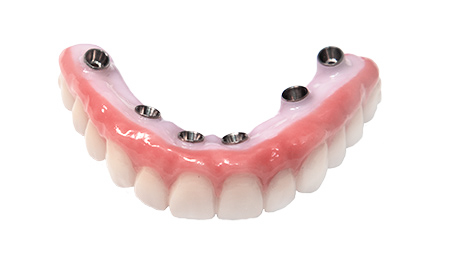Dental Sense - Truths
Dental Sense - Truths
Blog Article
The Single Strategy To Use For Dental Sense
Table of ContentsThe Facts About Dental Sense UncoveredAbout Dental Sense10 Easy Facts About Dental Sense DescribedThe smart Trick of Dental Sense That Nobody is Talking About
are clinical devices operatively dental implanted right into the jaw to bring back an individual's capability to chew or their appearance. They offer support for fabricated (phony) teeth, such as crowns, bridges, or dentures. When a tooth is lost due to injury or condition, a person can experience complications such as quick bone loss, defective speech, or changes to chewing patterns that cause pain.Dental implant systems include an oral implant body and oral implant joint and might likewise include a joint addiction screw. Root canal procedure. The oral implant body is surgically put in the jawbone instead of the tooth's root. The oral implant abutment is normally affixed to the implant body by the abutment addiction screw and prolongs through gums right into the mouth to support the attached man-made teeth
(https://slides.com/dentalsense1)Framework of The Oral Implant System picking oral implants, talk to your oral provider regarding the possible advantages and dangers, and whether you are a prospect for the treatment. Points to think about: Your overall wellness is an essential aspect in identifying whether you are a good candidate for dental implants, for how long it will certainly take to recover, and the length of time the dental implant may stay in area.
Smoking cigarettes might impact the recovery process and lower the long-term success of the implant. The recovery process for the implant body might take numerous months or longer, throughout which time you normally have a short-lived joint instead of the tooth. the dental implant treatment: Very carefully adhere to the dental health directions offered to you by your dental service provider.
The Main Principles Of Dental Sense
Implant failing can cause the demand for another operation to repair or change the implant system. Restores the capability to eat Restores cosmetic appearance Aids keep the jawbone from reducing due to bone loss Protects the wellness of the bordering bone and periodontals Assists keep surrounding (neighboring) teeth stable Enhances top quality of life Damage to surrounding all-natural teeth throughout dental implant positioning Injury to the surrounding cells throughout surgical treatment, such as sinus perforation Injury during surgical procedure (for instance, fracture of surrounding jawbone) Inadequate function, such as seeming like the teeth do not attack together generally A sensation that the tooth hangs or twisting in position arising from an abutment screw loosening Implant body failure (looseness of the implant body) because of systemic infection, which might be more probable in individuals with unchecked diabetes due to regional infection in bone and periodontals sustaining the dental implant body due to postponed recovery, which might be more probable in individuals that smoke Trouble cleaning the gum tissues around the implant, resulting in poor dental hygiene Untreated gum disease Post-surgical pins and needles because of nerve impingement or damage Constantly alert healthcare service providers and imaging service technicians that you have dental implants before any kind of magnetic vibration imaging (MRI) or x-ray procedures.
FDA is not aware of any kind of adverse events reported for MRI or x-ray treatments with dental implants. Oral implants systems are usually made from materials that comply with worldwide consensus standards of the International Company for Standardization (ISO) or ASTM International. These requirements have details of what makes a secure material.

A dental implant is a structure that replaces a missing out on tooth. With screw-like devices, the specialist inserts an implant into the jawbone, and it acts as an anchor for a synthetic tooth, called a crown. A tool called an abutment links the fabricated tooth to the dental implant. The crown is tailor-made to fit the individual's mouth and match the shade of their teeth.
Dental Sense Things To Know Before You Get This
Some people are not eligible for dental implant surgical procedure. It is for dental specialists to operate individuals with: intense illnessuncontrollable metabolic diseasebone or soft tissue disease or infectionIf these concerns are dealt with, a person can have the surgery. In, oral cosmetic surgeons avoid operating people with: If individuals with any of the above undergo dental implant surgical treatment, there is a higher risk of the implant falling short.

Oral implant surgical procedure is a personalized process. It's not the very same for everyone. But the following offers a general summary of what you can anticipate your dental practitioner, dental specialist, periodontist or prosthodontist to do: Put the dental implant operatively. Offer you time to heal. Connect the post and final crown, bridge or denture.
Next off, your specialist will very carefully position the dental implant into your jaw. If your implant is near the front of your mouth, your dentist will certainly make a momentary tooth for you to put on up until you recover.
Things about Dental Sense
Your provider can inform you what to anticipate in your situation. During the healing phase, your jawbone must fuse to the oral implant. This process, called osseointegration, is vital for stability and long-lasting success. This process can take anywhere from 3 to 9 months. Sometimes, it may take longer.
When your implant heals, your dental practitioner can attach the abutment (little port article) and your last reconstruction (crown, bridge or denture). This normally takes about one hour to complete and might need a second small surgical treatment. You should not really feel any type of pain throughout your dental implant treatment since your supplier will use medicine to numb your periodontals.
Report this page